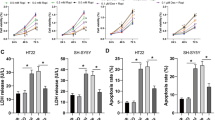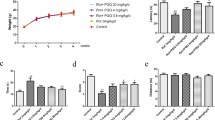Abstract—
STAT3 has neuroprotective effect via non-canonical activation and mitochondrial translocation, but its effect on ropivacaine-induced neurotoxicity remains unclear. Our previous study revealed that apoptosis was an important mechanism of ropivacaine-induced neurotoxicity; this study is to illustrate the relationship between STAT3 with ropivacaine-induced apoptosis. Those results showed that ropivacaine treatment decreased cell viability, induced cell cycle arrest in the G0/G1 phase, apoptosis, oxidative stress, and mitochondrial dysfunction in PC12 cells. Moreover, ropivacaine decreased the phosphorylated levels of STAT3 at Ser727 and downregulated the expression of STAT3 upstream gene IL-6. The mitochondrial translocation of STAT3 was also hindered by ropivacaine. To further illustrate the connection of STAT3 protein structure with ropivacaine, the autodock-vina was used to examine the interaction between STAT3 and ropivacaine, and the results showed that ropivacaine could bind to STAT3’s proline site and other sites. In addition, the activator and inhibitor of mitoSTAT3 translocation were used to demonstrate it was involved in ropivacaine-induced apoptosis; the results showed that enhancing the mitochondrial STAT3 translocation could prevent ropivacaine-induced apoptosis. Finally, the expression of p-STAT3 and the levels of apoptosis in the spinal cord were also detected; the results were consistent with the cell experiment; ropivacaine decreased the expression of p-STAT3 protein and increased the levels of apoptosis in the spinal cord. We demonstrated that ropivacaine induced apoptosis by inhibiting the phosphorylation of STAT3 at Ser727 and the mitochondrial STAT3 translocation. This effect was reversed by the activation of the mitochondrial STAT3 translocation.







Similar content being viewed by others
Data Availability
Data that support the study findings are available from the corresponding author upon reasonable request.
References
Martin-Flores, M. 2019. Epidural and spinal anesthesia. The Veterinary clinics of North America Small animal practice 49: 1095–1108.
Cm, C., T. Gr, M. Lg, and A P, LA N, M F-M, AL dO, S A, DR dA, E dP. 2012. Local neurotoxicity and myotoxicity evaluation of cyclodextrin complexes of bupivacaine and ropivacaine. Anesthesia and analgesia 115: 1234–1241.
Cai, X.Y., Y. Xia, S.H. Yang, X.Z. Liu, Z.W. Shao, Y.L. Liu, W. Yang, and L.M. Xiong. 2015. Ropivacaine- and bupivacaine-induced death of rabbit annulus fibrosus cells in vitro: Involvement of the mitochondrial apoptotic pathway. Osteoarthritis and cartilage 23: 1763–1775.
Aps, J., and N. Badr. 2020. Narrative review: The evidence for neurotoxicity of dental local anesthetics. Journal of dental anesthesia and pain medicine 20: 63–72.
Chen, Y., L. Yan, Y. Zhang, and X. Yang. 2019. The role of DRP1 in ropivacaine-induced mitochondrial dysfunction and neurotoxicity. Artificial cells, nanomedicine, and biotechnology 47: 1788–1796.
Wang, S., Q. Lin, Z. Wang, and X. Pan. 2019. Ropivacaine induces neurotoxicity by activating MAPK/p38 signal to upregulate Fas expression in neurogliocyte. Neuroscience Letters 706: 7–11.
Wen, X., Y. Li, X. Liu, C. Sun, J. Lin, W. Zhang, Y. Wu, and X. Wang. 2019. Roles of CaMKIIβ in the neurotoxicity induced by ropivacaine hydrochloride in dorsal root ganglion. Artificial cells, nanomedicine, and biotechnology 47: 2948–2956.
Zeng, Y., R. Wang, Y. Bian, W. Chen, and L. Peng. 2019. Catalpol attenuates IL-1β induced matrix catabolism, apoptosis and inflammation in rat chondrocytes and inhibits cartilage degeneration. Medical science monitor: International medical journal of experimental and clinical research 25: 6649–6659.
Sgrignani J., M. Garofalo, M. Matkovic, J. Merulla, CV. Catapano, and A. Cavalli. 2018. Structural biology of STAT3 and its implications for anticancer therapies development. International journal of molecular sciences, 19: 1591.
Vogel, T.P., J.D. Milner, and M.A. Cooper. 2015. The Ying and Yang of STAT3 in human disease. Journal of clinical immunology 35: 615–623.
Guanizo, A.C., C.D. Fernando, D.J. Garama, and D.J. Gough. 2018. STAT3: A multifaceted oncoprotein. Growth factors (Chur, Switzerland) 36: 1–14.
Hillmer, E.J., H. Zhang, H.S. Li, and S.S. Watowich. 2016. STAT3 signaling in immunity. Cytokine & growth factor reviews 31: 1–15.
Fathi, N., G. Rashidi, A. Khodadadi, S. Shahi, and S. Sharifi. 2018. STAT3 and apoptosis challenges in cancer. International journal of biological macromolecules 117: 993–1001.
Srivastava, J., and J. DiGiovanni. 2016. Non-canonical Stat3 signaling in cancer. Molecular carcinogenesis 55: 1889–1898.
Yang, R., and M. Rincon. 2016. Mitochondrial Stat3, the need for design thinking. International journal of biological sciences 12: 532–544.
Szczepanek, K., Q. Chen, M. Derecka, F.N. Salloum, Q. Zhang, M. Szelag, J. Cichy, R.C. Kukreja, J. Dulak, E.J. Lesnefsky, and A.C. Larner. 2011. Mitochondrial-targeted Signal transducer and activator of transcription 3 (STAT3) protects against ischemia-induced changes in the electron transport chain and the generation of reactive oxygen species. The Journal of biological chemistry 286: 29610–29620.
Heusch, G., J. Musiolik, N. Gedik, and A. Skyschally. 2011. Mitochondrial STAT3 activation and cardioprotection by ischemic postconditioning in pigs with regional myocardial ischemia/reperfusion. Circulation research 109: 1302–1308.
Flanagan, S.E., E. Haapaniemi, M.A. Russell, R. Caswell, H.L. Allen, E. De Franco, T.J. McDonald, H. Rajala, A. Ramelius, J. Barton, K. Heiskanen, T. Heiskanen-Kosma, M. Kajosaari, N.P. Murphy, T. Milenkovic, M. Seppänen, Å. Lernmark, S. Mustjoki, T. Otonkoski, J. Kere, N.G. Morgan, S. Ellard, and A.T. Hattersley. 2014. Activating germline mutations in STAT3 cause early-onset multi-organ autoimmune disease. Nature genetics 46: 812–814.
Steward-Tharp, S.M., A. Laurence, Y. Kanno, A. Kotlyar, A.V. Villarino, G. Sciume, S. Kuchen, W. Resch, E.A. Wohlfert, K. Jiang, K. Hirahara, G. Vahedi, H.W. Sun, L. Feigenbaum, J.D. Milner, S.M. Holland, R. Casellas, F. Powrie, and J.J. O’Shea. 2014. A mouse model of HIES reveals pro- and anti-inflammatory functions of STAT3. Blood 123: 2978–2987.
Y H, L W, J G, X J, F J, J Y. 2016. A modified procedure for lumbar intrathecal catheterization in rats. Neurological research 38: 725–732.
Z S, H L, Q G, X X, Z Z, N W. 2012. In vivo and in vitro evidence of the neurotoxic effects of ropivacaine: The role of the Akt signaling pathway. Molecular medicine reports 6: 1455–1459.
A B, S F, G L, D B. 2017. Transient neurologic symptoms (TNS) after intrathecal injection of ropivacaine through a dural tap during an attempted epidural for labour pain relief. Anaesthesia, critical care & pain medicine 36: 325–326.
W Z, BM G. 2008. The toxicity of local anesthetics: The place of ropivacaine and levobupivacaine. Current opinion in anaesthesiology 21: 645–650.
S C, S S. 2018. The role of local anaesthetic techniques in ERAS protocols for thoracic surgery. Journal of thoracic disease 10: 1998–2004.
Yamashita A., M. Matsumoto, S. Matsumoto, M. Itoh, K. Kawai, and T. Sakabe. 2003. A comparison of the neurotoxic effects on the spinal cord of tetracaine, lidocaine, bupivacaine, and ropivacaine administered intrathecally in rabbits. Anesthesia and analgesia, 97: 512–519.
Byram, S.C., S.E. Bialek, V.A. Husak, D. Balcarcel, J. Park, J. Dang, and E.M. Foecking. 2020. Distinct neurotoxic effects of select local anesthetics on facial nerve injury and recovery. Restorative neurology and neuroscience 38: 173–183.
Lirk P, I., Haller, H.P. Colvin, L. Lang, B. Tomaselli, L. Klimaschewski, and P. Gerner. 2008. In vitro, inhibition of mitogenactivated protein kinase pathways protects against bupivacaine- and ropivacaine-induced neurotoxicity. Anesthesia and analgesia, 106: 1456–1464.
Guryay, D., G. Karaege, K. Katircioglu, M. Ozkalkanli, U. Ozgurbuz, and S. Savaci. 2008. The effects of an epidural infusion of ropivacaine versus saline on sensory block after spinal anesthesia. Regional anesthesia and pain medicine 33: 217–221.
Takenami, T., S. Yagishita, F. Asato, M. Arai, and S. Hoka. 2002. Intrathecal lidocaine causes posterior root axonal degeneration near entry into the spinal cord in rats. Regional anesthesia and pain medicine 27: 58–67.
S W, Q L, Z W, X P. 2019. Ropivacaine induces neurotoxicity by activating MAPK/p38 signal to upregulate Fas expression in neurogliocyte. Neuroscience letters 706: 7–11.
Z N, J T, Y R, W F. 2018. Ropivacaine impairs mitochondrial biogenesis by reducing PGC-1α. Biochemical and biophysical research communications 504: 513–518.
El-Deiry, W.S. 2016. p21(WAF1) Mediates cell-cycle inhibition, relevant to cancer suppression and therapy. Cancer research 76: 5189–5191.
Schade, A.E., M.G. Oser, H.E. Nicholson, and J.A. DeCaprio. 2019. Cyclin D-CDK4 relieves cooperative repression of proliferation and cell cycle gene expression by DREAM and RB. Oncogene 38: 4962–4976.
Xu, W., and G. McArthur. 2016. Cell cycle regulation and melanoma. Current oncology reports 18: 34.
Lim, S., and P. Kaldis. 2013. Cdks, cyclins and CKIs: Roles beyond cell cycle regulation. Development (Cambridge, England) 140: 3079–3093.
Y C, L Y, Y Z, X Y. 2019. The role of DRP1 in ropivacaine-induced mitochondrial dysfunction and neurotoxicity. Artificial cells, nanomedicine, and biotechnology 47: 1788–1796.
You, L., Z. Wang, H. Li, J. Shou, Z. Jing, J. Xie, X. Sui, H. Pan, and W. Han. 2015. The role of STAT3 in autophagy. Autophagy 11: 729–739.
Cui, P., F. Wei, J. Hou, Y. Su, J. Wang, and S. Wang. 2020. STAT3 inhibition induced temozolomide-resistant glioblastoma apoptosis via triggering mitochondrial STAT3 translocation and respiratory chain dysfunction. Cellular signalling, 71: 109598.
Li, H., W. Yao, Z. Liu, A. Xu, Y. Huang, X.L. Ma, M.G. Irwin, and Z. Xia. 2016. Hyperglycemia abrogates ischemic postconditioning cardioprotection by impairing AdipoR1/Caveolin-3/STAT3 signaling in diabetic rats. Diabetes 65: 942–955.
Zhang, G., M. Sheng, J. Wang, T. Teng, Y. Sun, Q. Yang, and Z. Xu. 2018. Zinc improves mitochondrial respiratory function and prevents mitochondrial ROS generation at reperfusion by phosphorylating STAT3 at Ser(727). Journal of molecular and cellular cardiology 118: 169–182.
Funding
The Innovative Research Program for Graduates of Hubei University of medicine (NO. YC2020029), Hubei Natural Science Foundation (No. 2019CFB105).
Author information
Authors and Affiliations
Contributions
LHY and DXD designed the studies; ZL, LAH, and ZZ undertook the cell experiments and the construction of animal experiment; ZL and ZFY undertook the molecular biology testing; ZL, CHX, and WY undertook the molecular docking. ZL, ZFY, and ZZ analyzed data and wrote the draft of manuscript; ZL and LAH undertook the revision of manuscript.
Corresponding author
Ethics declarations
Ethical Approval and Consent to Participate
All procedures performed in studies involving animals were in accordance with the ethical standards of the institution or practice at the Animal Ethics Committee of the Hubei University of Medicine (permit number 2018DW003).
Consent for Publication
The authors declare the consent for publication.
Competing Interests
The authors declare no competing interests.
Additional information
Publisher's Note
Springer Nature remains neutral with regard to jurisdictional claims in published maps and institutional affiliations.
Supplementary Information
Below is the link to the electronic supplementary material.
10753_2021_1508_MOESM1_ESM.pdf
Supplementary file1 Supplementary Fig. 1 Ropivacaine promotes the protein expression of Cytochrome c and cleaved-PARP. A: The protein expression of Cytochrome c, PARP and GAPDH was detected by Western-blot. B: Quantification of the gray values in graphs A. C: Effect of ropivacaine on the colocalization of mitochondria (red) and Cytochrome c (green) was detected by fluorescence microscope. (PDF 8043 KB)
Rights and permissions
About this article
Cite this article
Zeng, L., Li, A., Zhang, Z. et al. Ropivacaine Induces Cell Cycle Arrest in the G0/G1 Phase and Apoptosis of PC12 Cells via Inhibiting Mitochondrial STAT3 Translocation. Inflammation 44, 2362–2376 (2021). https://doi.org/10.1007/s10753-021-01508-w
Received:
Accepted:
Published:
Issue Date:
DOI: https://doi.org/10.1007/s10753-021-01508-w




